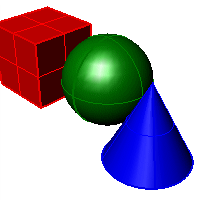Shaded display mode
Tools > Options > View > Display Modes > Shaded
The Shaded display mode sets the viewport to opaque shaded mode.
Shaded modes use a mesh to shade surfaces using the layer colors.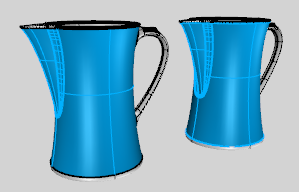
Display mode options
Name
Name of display mode.
Viewport settings
Background
Specifies the viewport background color.
Use application settings
Use settings specified in Appearance -> Color Options.
Solid color
To select a color
- Click the color swatch.
Image file
Specifies an image for the viewport background.
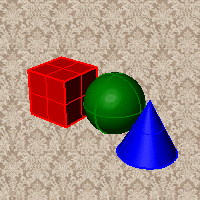
Image file name
- Type or browse for the file name.
Gradient 2 colors
Blends between a top and bottom color.
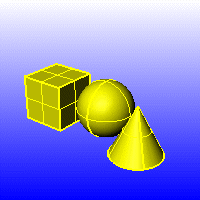
Top color / Bottom color
To select a color
- Click the color swatch.
Gradient 4 colors
Blends between four colors starting from the corners of the viewport.
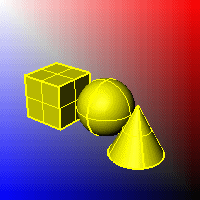
Top left color / Top right color / Bottom left color / Bottom right color
To select a color
- Click the color swatch.
Use render settings
Displays the colors and lighting used by the settings for background specified by the current renderer.
Transparent
Renders viewport backgrounds using black and a 0.0% alpha value. This works for rendered output and for ViewCaptureToFile.
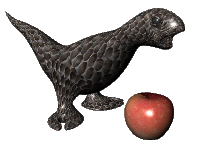
Ground plane settings
On
Turns on the ground plane for the display mode.
Shadow only
Makes the ground plane transparent, but allows shadows to still be cast on it.
Altitude
Sets the ground plane's height above the xy plane.
Automatic
Places the ground plane just below the lowest element in the model. As new objects are added to the scene, the ground plane can move.
Linear workflow settings
Gamma correction for bitmap images that are loaded from disk is removed (by the inverse of the amount in the Gamma edit box) so that they have a linear response before they are passed to the display. The display renders them in this uncorrected state. The gamma correction is applied to the entire finished image. This can do a better job of processing the color in rendered images.
See: Understanding Linear Workflow – Working In Floating Point
See: Understanding Linear Workflow Walkthrough
User render settings
Use settings from Document Properties > Render
Custom
Adjust input colors
Adjust input textures
Input gamma
Adjust output gamma
Output image gamma
Shading settings
Shade objects
Sets the viewport to opaque shaded mode.
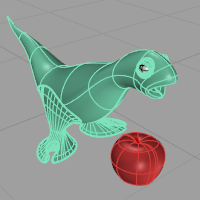
X-Ray all wires
Shades with isocurves not obscured by objects in front.
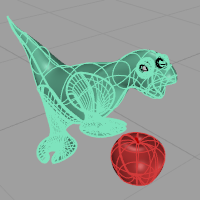
Flat shading
Shades the current viewport with no smoothing so the individual render mesh faces are visible.
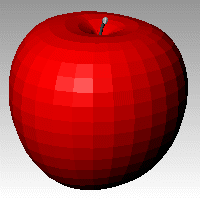
See: FlatShade.
Shade vertex colors
Shades using an object's vertex colors.
See: ComputeVertexColors.
Color and material usage
Single color for all objects
Ignores object colors and uses a single color for the shading.

Gloss
Sets the gloss for the color.
Transparency
Sets the transparency for the color.
Single object color
To select a color
- Click the color swatch.
Rendering material
Shades using rendering material.
Custom material for all objects
Click the button to specify the custom material.
Customize
Opens the Custom Object Attributes Settings dialog box.
Backface settings
Changes the color of the backface (the side opposite of the surface normal direction).
Use front face settings
No color change.

Cull backfaces
Surfaces viewed from the back will be transparent.

Use object's color
Surfaces viewed from the back use the color specified in the object's Properties.
Gloss
Sets the gloss for the backface material. This can be different from the front face material.
Transparency
Sets the transparency for the backface material. This can be different from the front face material.
Single color for all backfaces
All backfaces display a specified color regardless of the object color.
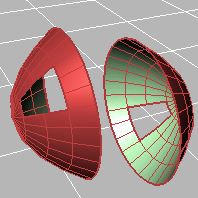
Gloss
Sets the gloss for the backface material. This can be different from the front face material.
Transparency
Sets the transparency for the backface material. This can be different from the front face material.
Single backface color
Sets a single color for all backfaces.
To select a color
- Click the color swatch.
Rendering material
Shades using rendering material.
Custom material for all backfaces
Click the button to specify the custom material.
Customize
Opens the Custom Object Attributes Settings dialog box.
Visibility
Specifies which elements will be visible in the display mode.
Show isocurves
Shows object isocurves.
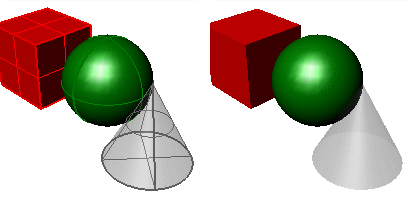
Isocurves on (left) and off (right).
Show tangent edges
Tangent polysurface edges are smooth edges between different faces of a polysurface.
Show tangent seams
Tangent seams are smooth edges that close surfaces such spheres or cylinders.
Shows mesh wires.
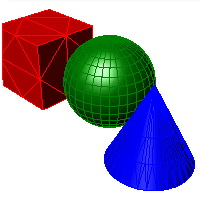
Show SubD wires
Toggles visibility of SubD smooth edges.
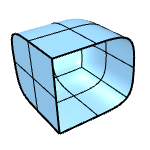
Show SubD creases
Toggles visibility of SubD creased edges.
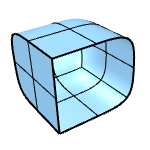
Show SubD boundaries
Toggles visibility of SubD naked edges.
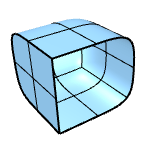
Show SubD symmetry
Toggles color differentiation of SubD symmetry children.
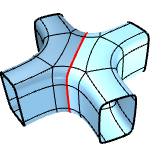
Change the display color of symmetry children
Show mesh wires
Toggles visibility of welded mesh edges.
Show curves
Shows curves objects.
Show lights
Shows lights objects
Show clipping planes
Shows clipping planes objects.
Show text
Shows text blocks.
Show annotations
Shows annotations objects.
Show points
Shows points objects.
Show pointclouds
Shows pointclouds objects
Lighting scheme
See Lighting scheme settings.
Grid
Objects
See Objects settings.
Points
See Points Settings.
Curves
See Curves Settings.
Surfaces
See Surfaces settings.
SubD
See SubD settings.
Meshes
See Meshes settings.
Lights
See Lights settings.
Clipping Planes
Shadows
See Shadows settings.
Other Settings
See Other Settings.
Restores the default system values. All custom appearance settings will be lost.
Save options for use on other computers
OptionsExport
Save Options settings to a file.
OptionsImport
Restore Options settings from a file.
